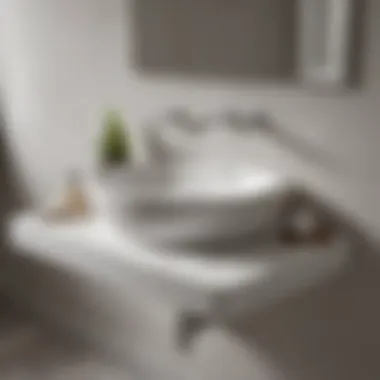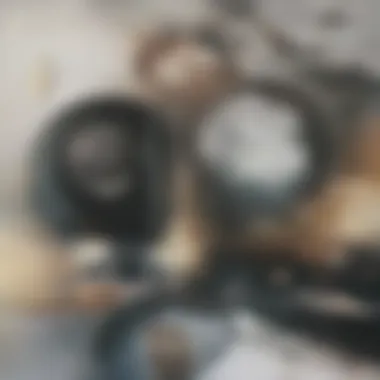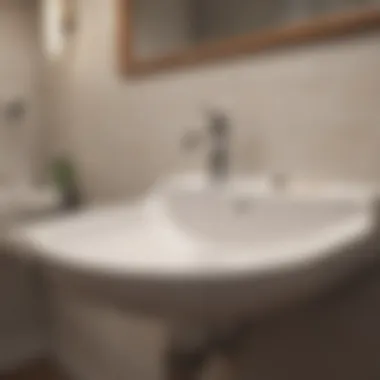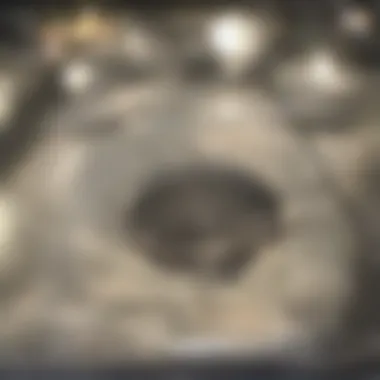Understanding Slow Draining Bathroom Sinks: Causes & Solutions


Intro
Slow draining bathroom sinks can be more than just a minor inconvenience. They often signify underlying issues that may need attention. Understanding why this happens, especially when there is no visible clog in the drain, is crucial for maintaining the functionality and aesthetic of your bathroom. This article aims to provide a comprehensive examination of the common causes of slow drainage and offers practical solutions that homeowners can implement.
Home Features
Architectural Considerations
Many bathroom designs incorporate particular features that can affect drainage performance. For instance, a sink with a shallow or poorly angled drain may cause water to drain slowly. Additionally, the placement of the sink in relation to the plumbing can play a significant role. If pipes are poorly installed or angled incorrectly, drainage efficiency diminishes.
Unique Design Aspects
Some bathrooms boast unique design elements that, while appealing, can complicate drainage. For example, vessel sinks – which sit above the countertop – often have specialized drain requirements. These types of sinks may lead to slower drainage if not paired correctly with suitable plumbing or if the drain height is inadequately set. Careful consideration during the design phase can prevent future issues.
Common Causes of Slow Draining Sinks
Understanding the causes behind slow draining sinks is essential for effective solutions. Here are some prevalent factors:
- Mineral Buildup: Over time, minerals from hard water can accumulate in pipes, especially at bends or joints, leading to reduced flow.
- Ventilation Issues: Plumbing systems rely on vents to allow air to enter and prevent vacuum formation during drainage. A blocked vent can slow down drainage significantly.
- Pipe Diameter: Smaller diameter pipes can restrict water flow. If the pipes are insufficient for the sink's design, this can lead to hassle.
Solutions for Homeowners
Here are some actions homeowners can take to mitigate slow draining sinks:
- Regular Cleaning: Schedule regular cleaning of drains to remove buildup. A mixture of vinegar and baking soda can help dissolve minor obstructions.
- Professional Inspection: Hiring a plumbing professional for an inspection can identify hidden issues. Problems like roots infiltrating pipes or damaged sections may require skilled intervention.
- Adjusting Plumbing Design: If design flaws are detected, consider redesigning the plumbing setup. A professional can reroute pipes for better flow.
Regular maintenance can prevent many issues associated with slow draining sinks and prolong system life.
The End
Slow draining bathroom sinks, while sometimes perceived as a mere nuisance, can reflect deeper issues requiring attention. By understanding the various contributing factors and possible solutions, homeowners can maintain their bathrooms effectively. This knowledge not only ensures an improved experience but also fosters a space that remains both functional and aesthetically pleasing. For more detailed discussions on home maintenance and design trends, you can explore resources like Wikipedia, Britannica, Reddit, and Facebook.
Prelude to Bathroom Drain Issues
Bathroom sink drainage is a vital aspect of a functional home. Slow draining sinks can be more than an annoyance they may signal deeper issues within the plumbing system. Understanding these issues can help homeowners make informed decisions about their bathrooms.
Slow draining sinks can disrupt daily routines. They can cause frustration as water pools in the basin, leading to concerns about hygiene and long-term plumbing problems. The importance of identifying the root causes of slow drainage cannot be overstated. By addressing the underlying issues, homeowners can prevent more severe plumbing problems down the line, which can result in costly repairs.
Defining Slow Draining Sinks
A slow draining sink is characterized by water taking a longer time than normal to exit the basin. This situation is not equivalent to clogged sinks, which are fully obstructed. Rather, slow draining can stem from various factors like design inefficiencies, mineral deposits, or systemic plumbing issues. Recognizing these distinctions is essential for effective diagnosis and remediation.
Homeowners often overlook slow drainage as a minor inconvenience. However, it can indicate a systemic flaw or maintenance need. Properly addressing slow draining issues can enhance the overall functionality of the space, improve user experience, and maintain the aesthetic appeal of the bathroom.
Common Misconceptions About Clogs
Many homeowners perceive slow draining sinks as straightforward clogs. This misconception can lead to ineffective monitoring and repairs. In reality, slow drainage can arise from several factors that do not necessarily involve full blockages.
Some common misconceptions include:
- Clogs are always obvious: People often assume they would know if a sink were fully blocked. However, slow drainage might occur due to partial blockages or buildup, eluding immediate detection.
- Only professional help can solve issues: Some believe that plumbing problems can only be handled by professionals. While complicated issues may require expertise, many slow draining issues can be addressed with household solutions.
- Chemical cleaners are a cure-all: There is a widespread idea that chemical drain cleaners will solve all drainage problems. This approach can sometimes cause more harm than good, including damaging pipes.
Recognizing these misconceptions is crucial in approaching slow draining issues. Homeowners should utilize knowledge about potential causes to better understand their specific situations and take appropriate action.


Anatomy of a Bathroom Sink Drain
The anatomy of a bathroom sink drain is fundamental in understanding slow drainage issues. Knowledge of how the various components work together is essential for diagnosing problems and implementing effective solutions. An examination of these elements allows homeowners to take proactive measures to maintain their sinks. Furthermore, understanding drainage mechanics provides insight into the overall plumbing system of a home, enhancing the user experience.
Components of a Sink Drain System
A typical sink drain system consists of several critical components:
- Sink Basin: This is the part where water collects and is the most visible element of the entire setup. Its design can affect drainage due to shape and size.
- P-Trap: This curved pipe below the sink is crucial for preventing sewer gases from entering the living space. It also collects debris that can lead to clogs if not maintained.
- Drain Pipe: The pipe that connects the P-trap to the wall or floor plumbing. The length and diameter of this pipe can significantly affect drainage efficiency.
- Vent Pipe: This component allows air into the plumbing system, helping stabilize pressure and ensuring proper drainage. A blocked vent can lead to slow drainage.
Recognizing these components helps in diagnosing the slow draining issue, as each part plays a role in the effectiveness of water flow.
Understanding Drainage Mechanics
Drainage mechanics refer to the way water flows through the sink drainage system. Several factors influence this flow:
- Gravity: Water flows downward due to gravity. Any bends or obstructions in the pipes can impede this flow.
- Pipe Configuration: The arrangement of pipes affects how quickly water moves through the system. Sharp turns, narrow pipes, or significant length can hinder drainage efficiency.
- Air Pressure: Proper ventilation is essential for maintaining consistent air pressure within the drainage system. Blockages in the vent system can create vacuum conditions that slow down water movement.
A comprehensive understanding of these mechanics not only aids in identifying current issues but also helps in preventing future problems. By implementing necessary adjustments or maintaining the system, homeowners can improve their bathroom sink's performance.
Identifying the Causes of Slow Drainage
Identifying the causes of slow drainage is crucial for effective resolution and prevention of further issues. A slow-draining sink can signal underlying problems that, if left unchecked, can lead to more significant plumbing issues and even costly repairs. Understanding the different causes helps homeowners diagnose issues accurately and determine whether they can address them or need professional help. This section will unpack several common factors contributing to slow drainage in bathroom sinks.
Design Flaws in Sink Systems
Design flaws in sink systems are a common contributor to slow drainage. Some sinks may have a poor slope or an inadequate trap size that can limit the water flow. Sometimes, the design may not take into account the typical usage or the plumbing layout of the home. For example, when a sink is installed too high or improperly positioned, the water can struggle to flow freely toward the main drain. Additionally, some older homes have outdated plumbing systems that do not follow modern standards, which can exacerbate drainage issues. A careful examination of the design is essential.
Impact of Mineral Deposits
Mineral deposits are another factor affecting sink drainage. Many households have hard water, which contains high levels of calcium and magnesium minerals. Over time, these minerals can accumulate inside the pipes and fittings, leading to reduced water flow. This build-up might not be noticeable at first, but it progressively narrows the passage, causing slow drainage issues. Regular checks and maintenance can help minimize the buildup of these deposits. Homeowners might consider installing a water softener to combat this issue effectively.
Effects of Ventilation Issues
Ventilation issues can significantly affect sink drainage. Plumbing systems require proper venting for air pressure regulation. If vents are blocked or improperly designed, the air cannot flow freely in the pipes. This lack of air circulation creates a vacuum effect, which can slow water drainage. It is essential to review the venting system if slow drainage persists. Regular inspections can help ensure that vents are clear of debris or blockages.
The Role of Pipe Size and Configuration
The size and configuration of pipes play a crucial role in drainage effectiveness. Pipes that are too small or incorrectly angled can severely restrict flow. The angle of the pipes should ideally allow gravity to assist drainage. If water has to travel through a long, horizontally placed section, it can hinder drainage flow. It is important to consider both the diameter and placement of pipes when assessing drainage issues.
Debris and Residue Accumulation
Finally, debris and residue accumulation inside the sink and drain can cause noticeable slowdowns in drainage. This accumulation often consists of hair, soap scum, and organic materials. To identify this issue, homeowners may conduct a visual inspection of their drains and check p-traps for clogs. Regular cleaning can minimize this problem. Homeowners should develop a routine maintenance schedule to keep their sink area clear of obstructions.
Proper identification of slow drainage causes is the first step towards an effective remedy. Ignoring the signs can lead to larger plumbing dilemmas.
Diagnosing Slow Draining Sinks
Diagnosing slow draining sinks is crucial for homeowners who wish to maintain a functional bathroom. Understanding the underlying issues can prevent future headaches and costly repairs. Proper diagnosis not only improves the sink's performance but also helps in prolonging the lifespan of the plumbing system.
When sinks drain slowly, it indicates there may be problems that need attention beyond simple cleaning. Without accurate diagnosis, homeowners may engage in unnecessary repairs or use inappropriate methods to fix the issue.
Visual Inspections
Visual inspections are the first step in diagnosing a slow draining sink. By examining the sink and surrounding fixtures, one can identify potential problems.


Look for:
- Water pooling: Standing water in the sink is a primary indicator of drainage issues.
- Leaking pipes: Inspect the under-sink area for any signs of leaks or corrosion.
- Visible debris: Check for hair, soap scum, or other debris that might be partially clogging the drain.
A careful visual inspection can reveal obvious blockages or maintenance needs that might not require extensive tools or professional help.
Testing Water Flow
Testing water flow is another effective method for diagnosing slow drains. This involves running water and observing the behavior.
Consider the following steps:
- Turn on the faucet and watch how quickly water drains away.
- Take note of unusual noises, like gurgling.
- Check if water backs up in other fixtures, like the tub or toilet.
If the sink appears slow under normal circumstances, but drains well when cleared, this points to potential issues in the waste pipes or the venting system.
Using Plumbing Tools for Diagnosis
Employing plumbing tools can greatly assist in diagnosing drainage issues. Several tools serve different purposes, providing insights into the problem:
- Plumbing snake: Can help in detecting blockages deep within the pipes.
- Pipe cameras: These offer a visual inspection of the interior of pipes and drain systems.
- Basin wrenches: Useful for removing P-traps and cleaning sudden accumulations of residue.
By using these tools, homeowners can identify specific problems and address them more effectively.
Diagnosing slow draining sinks early can prevent more significant plumbing issues down the road.
Remedies for Slow Draining Sinks
Addressing slow draining sinks is crucial for maintaining not just functionality but also overall hygiene in the bathroom. Slow drains can contribute to unpleasant odors and water pooling, which might attract pests. Understanding the remedies available helps homeowners act promptly to prevent more significant issues. This section covers various methods that can alleviate the problem.
Cleaning Techniques for Drain Lines
Cleaning the drain line is essential in improving flow. Several methods can be utilized, categorized as chemical cleaners, natural solutions, and mechanical cleaning methods. Each comes with advantages and certain limitations.
Chemical Cleaners
Chemical cleaners are often the first choice for many homeowners facing slow drains. Their key characteristic is their strong formulation that breaks down debris and buildup. For example, products like Drano or Liquid-Plumr are designed for ease of use. They require pouring the cleaner down the drain and waiting for a specified period for results.
The primary advantage of chemical cleaners is their effectiveness. They can quickly clear clogs caused by hair, soap scum, and grease. However, they may be corrosive and can damage pipes if used excessively or improperly. Therefore, while they offer an immediate solution, caution is advised with frequent usage.
Natural Solutions
Natural solutions provide an eco-friendly alternative to chemical cleaners. Common household items like baking soda and vinegar make a popular combination. The method involves pouring baking soda down the drain, followed by vinegar, and then flushing with hot water. This solution capitalizes on the reaction between soda and vinegar to dislodge buildup.
The primary characteristic of natural methods is their safety for both plumbing and the environment. They are gentle enough not to corrode pipes while being effective against minor clogs. However, they may not work as quickly as chemical solutions for more severe blockages. Their use promotes a healthier living environment, aligning with eco-conscious practices.
Mechanical Cleaning Methods
Mechanical cleaning methods involve physical tools such as plungers or augers. Plungers can often provide a quick fix for shallow clogs by creating a vacuum effect, while augers can reach deeper into pipes. This approach is practical when dealing with significant obstructions.
One key feature of mechanical methods is their immediate feedback. Homeowners can see results in real time. They do not carry the risks associated with chemical exposure. However, they require more manual effort and may not always effectively penetrate stubborn clogs.
Inspecting and Maintaining P-Traps
The P-trap is a critical component of bathroom sinks. Inspecting it regularly can prevent slow drainage issues. A P-trap collects debris to prevent it from entering drainage systems. If it becomes clogged, it can restrict water flow. Maintenance includes checking for leaks and cleaning out any collected residue periodically.


Addressing Ventilation Problems
Proper ventilation of plumbing systems is vital for optimal drainage. A poorly ventilated system may lead to slow drains and gurgling sounds. Solutions may involve checking vent pipes for blockages or irregularities. Ensuring vents are clear allows air to flow freely in drain lines, promoting efficient drainage.
Consulting Professional Plumbers
When remedies fail or problems persist, consulting professional plumbers is advisable. They possess the expertise and specialized tools to diagnose and fix complex issues. Additionally, they can provide insights into potential underlying causes that homeowners might overlook. This step typically results in a longer-lasting solution, mitigating future drainage problems.
Preventive Measures for Future Drainage Issues
Preventive measures are essential to ensure that bathroom sinks continue to function efficiently over time. Establishing a routine helps in avoiding bigger issues that can arise from neglect. Implementing preventive actions protects not just the drainage system but also saves money on potential repairs. Moreover, consistent maintenance contributes to better hygiene, minimizing any unpleasant odors resulting from stagnant water.
Regular Cleaning and Maintenance Routine
A regular cleaning and maintenance routine is significant in preventing slow drainage. Carrying out simple tasks can stop debris and residues from building up in pipes. Homeowners should aim to flush the sink with hot water at least once a week. This practice helps dissolve minor grease and soap scum deposits.
Additionally, using a mixture of baking soda and vinegar once a month can address early signs of buildup.
Here are a few suggestions for a cleaning routine:
- Flush the sink with hot water frequently.
- Utilize natural solutions like baking soda and vinegar monthly.
- Inspect and clean the P-trap as needed.
- Avoid pouring fats or oils down the drain.
Keeping the drain clean will prolong the efficiency of the drainage system in the bathroom.
Educating Household Members on Proper Use
Education is crucial for everyone in the household. Ensuring that all members understand how to use the sink correctly can play a vital role in preventing drainage issues. This means explaining the importance of not using the sink as a trash can for items such as hair, food scraps, or cosmetic products.
Encourage family and guests to:
- Dispose of non-biodegradable items properly.
- Rinse dishes before placing them in the sink.
- Avoid excessive use of soaps that produce residue.
Developing a culture of proper usage will minimize unnecessary strain on the drainage system.
Monitoring for Warning Signs
It is wise to keep an eye out for early warning signs of drainage issues. Catching a problem early can save time, money, and hassle in the long run. Homeowners should be on the lookout for:
- Unpleasant odors emanating from the sink.
- Water backing up, even slightly.
- Drainage that becomes slower over time.
Monitoring these signs can prompt prompt action, ensuring that the plumbing remains functional and effective. Should issues surface, addressing them quickly will minimize further complications.
"Prevention is better than cure." By following these preventive measures, homeowner can keep their sinks draining smoothly and efficiently.
The End: Ensuring Efficient Sink Drainage
In this article, we explored the intricate dynamics around slow draining bathroom sinks. It is essential to understand that efficient sink drainage is not just a matter of convenience; it underpins the overall functionality and hygiene of your bathroom space. Homeowners must recognize that a slow draining sink can lead to larger plumbing issues if not addressed promptly.
In assessing the causes, we identified significant factors such as design flaws, mineral deposits, and ventilation issues. Each of these aspects plays a crucial role in the flow of water, affecting not only drainage efficiency but potentially causing structural concerns in the plumbing system over time. It is this intricate relationship that highlights the importance of proper maintenance and timely interventions.
Summarizing Key Takeaways
- Understanding Causes: Knowledge of various causes can help in early detection. Issues like design flaws and mineral build-up should not be overlooked. Both require attention to avoid bigger, more expensive repairs.
- Effective Solutions: Implementing cleaning techniques, inspecting components like the P-trap, and addressing ventilation are practical steps homeowners can take to mitigate drainage issues.
- Routine Maintenance: Establishing a regular cleaning and maintenance routine ensures that minor issues do not escalate. Simple measures can save time and resources in the future.
"Routine checks are essential for a well-functioning plumbing system."
Future Considerations for Homeowners
Looking ahead, homeowners should prioritize educational resources related to plumbing and drainage systems. Keeping abreast of the potential warning signs can aid in understanding when professional intervention is necessary. The balance between aesthetics and functionality in bathroom design should also be considered. For instance, while attractive fixtures enhance visual appeal, ensuring they are compatible with effective drainage should remain a priority. With proper knowledge and consistent practice, it is possible to maintain an efficient sink drainage system that complements the overall integrity of your bathroom.
By creating an informed approach, each homeowner can take pride in maintaining an efficient bathroom environment, enhancing comfort and efficiency within their living space.



